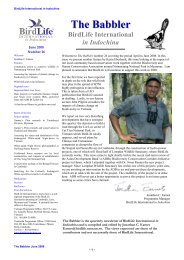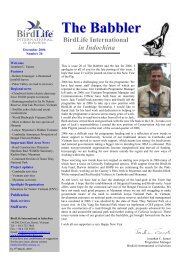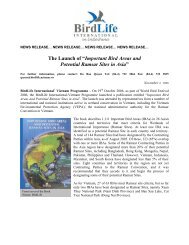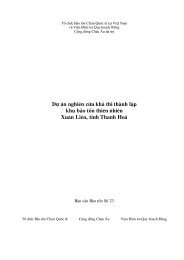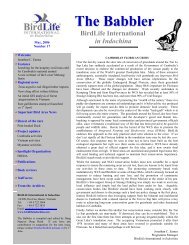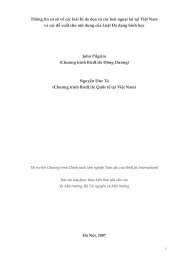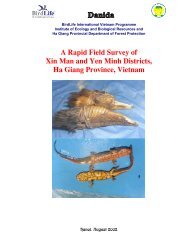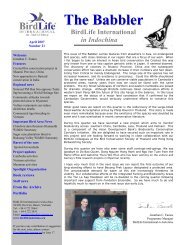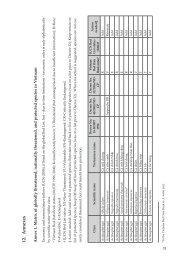Bird Life Tieng Anh-01.qxd - Birdlife International in Indochina
Bird Life Tieng Anh-01.qxd - Birdlife International in Indochina
Bird Life Tieng Anh-01.qxd - Birdlife International in Indochina
Create successful ePaper yourself
Turn your PDF publications into a flip-book with our unique Google optimized e-Paper software.
People’s Commitee <strong>in</strong> 1997. This proposed the establishment of a 13,696 ha nature reserve,<br />
compris<strong>in</strong>g a strict protection area of 4,463 ha, a forest rehabilitation area of 7,695 ha and an<br />
adm<strong>in</strong>istration and services area of 1,538 ha. However, the reserve has not yet been decreed by<br />
the government, nor a management board established. Thai Thuy is not <strong>in</strong>cluded on the list of<br />
Special-use Forests to be established by 2010, prepared by the FPD of MARD. Currently, two local<br />
community groups are <strong>in</strong>volved <strong>in</strong> management of the site: Thuy Truong and Thuy Xuan Commune<br />
Environment Groups <strong>in</strong> the north and south respectively.<br />
Vegetation. The pr<strong>in</strong>cipal species of coastal areas are Bruguiera gymnorrhiza, Kandelia candel,<br />
Aegiceras corniculatum and Acanthus ilicifolia. The ma<strong>in</strong> tall species present, up to 3–4 m high,<br />
is Sonneratia caseolaris, which has been reduced to 3–6 trees/m2 through cutt<strong>in</strong>g, and there are also<br />
scattered trees of Avicennia latana, B. gymnorrhiza and Aegiceras corniculatum. In the broken<br />
marg<strong>in</strong>s of alluvial soils Acanthus ilicifolius is develop<strong>in</strong>g well and Aegiceras corniculatum and<br />
B. gymnorrhiza sometimes up to 1.5 m tall are found. Phragmites vallatonia occurs ma<strong>in</strong>ly <strong>in</strong><br />
aquacultural ponds adjacent to the estuary. In marshy areas between the dyke and the river B.<br />
gymnorrhiza, Aegiceras corniculatum and K. candel grow. Although plants are 5–7 years old<br />
they are only 0.7–1 m tall. Vegetation along dyke and pond marg<strong>in</strong>s <strong>in</strong>cludes Ziziphus oenoplia,<br />
Datura metel, Clerodendrum <strong>in</strong>erme, Premma <strong>in</strong>tergrifolia, Lantana camara, Pandanus aff<strong>in</strong>is and<br />
Derris trifoliata, and the recently recorded, climb<strong>in</strong>g Cayratia trifolia. Much Calotropis gigantea<br />
has developed <strong>in</strong> patches 10–20 m long and 1–2 m wide. Several grass species ma<strong>in</strong>ta<strong>in</strong> the soils<br />
along the dyke and throughout several herb species occur, <strong>in</strong>clud<strong>in</strong>g Cr<strong>in</strong>um asiaticum and<br />
Acrostichum aureum.<br />
Socio-economic issues. Around 29,000 people at a density of 2,300/km2 live <strong>in</strong> the region of Thai<br />
Thuy, Thai Thuy district, <strong>in</strong> three communes; Thuy Truong, Thuy Xuan and Thuy Hai. The largest<br />
is Thuy Xuan commune with 11,000 people at a density of 3,000/km2 . Most live <strong>in</strong> the centre of<br />
the community and along the sea dykes. The economy of Thuy Xuan and Thuy Hai communes is<br />
based on fish<strong>in</strong>g, aquaculture and salt production, with 70% of the people <strong>in</strong>volved <strong>in</strong> fish<strong>in</strong>g and<br />
aquaculture, 20% <strong>in</strong>volved <strong>in</strong> salt production. Thuy Xuan, Thuy Hai communes and Diem Dien<br />
town produce roughly 60% of the district’s total aquaculture production. Thuy Truong commune<br />
is largely <strong>in</strong>volved <strong>in</strong> agriculture, ma<strong>in</strong>ly rice production, which is cropped twice a year, up to 10<br />
tonnes per ha, and any aquaculture is located outside the ma<strong>in</strong> dyke <strong>in</strong> concrete-banked ponds 5<br />
ha <strong>in</strong> size. Mangrove and grasses are grown <strong>in</strong> the ponds to prevent wave and storm damage. There<br />
is small-scale trade associated with the aquaculture and agriculture <strong>in</strong>dustries.<br />
Important avifauna. Thai Thuy is one of the most important w<strong>in</strong>ter<strong>in</strong>g areas for migratory birds<br />
<strong>in</strong> the Red River Delta, with around 100 species recorded at the site dur<strong>in</strong>g 2005/2006 <strong>in</strong>clud<strong>in</strong>g<br />
six globally threatened or Near-Threatened species. Notably these <strong>in</strong>cluded a maximum of 288<br />
Saunders’s Gulls Larus saundersi, some 3.4% of the Asian biogeographic (global) population, 2 and<br />
four <strong>in</strong>dividuals of the <strong>in</strong>creas<strong>in</strong>gly rare Spoon-billed Sandpiper Eurynorhynchus pygmeus. The<br />
others were two species of duck; Baer’s Pochard Aythya baeri and Ferrug<strong>in</strong>ous Pochard A. nyroca,<br />
and two raptors; Greater Spotted Eagle Aquila clanga and Imperial Eagle A. heliaca, although the<br />
site is not likely to hold significant populations of any of these. All except the last of these threatened<br />
species are newly reported from the site, but of concern is the fact that the small populations of<br />
Ch<strong>in</strong>ese Egret Egretta eulophotes, Black-headed Ibis Threskiornis melanocephalus and Black-faced<br />
Spoonbill Platalea m<strong>in</strong>or have apparently dw<strong>in</strong>dled and disappeared over the last decade (Tordoff<br />
(ed.) 2002). The site cont<strong>in</strong>ues to rema<strong>in</strong> important for many species of shorebirds, herons, gulls<br />
and passer<strong>in</strong>es. Of particular note are 503 Great Egrets Casmerodius albus (2% of the Asian<br />
biogeographic population) reported <strong>in</strong> January 2006, 520 Common Greenshanks Tr<strong>in</strong>ga nebularia<br />
(close to 550, 1% of the Asian biogeographic population) <strong>in</strong> December 2005 and 253 Gull-billed<br />
11




